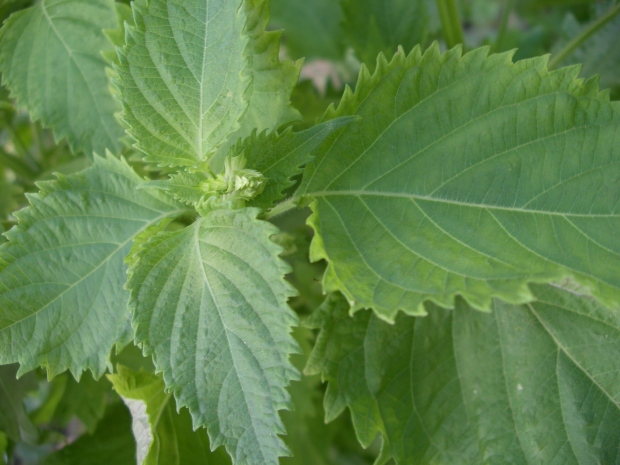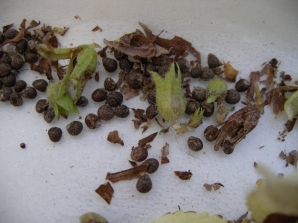Posts Tagged perilla frutescens
Perilla (Shiso)
Posted by Laura Hudson in A-Z Edibles, Herbs, Leaves & Salad, Perennials & Self-seeders on June 2, 2013
Tender Self-Seeding leafy herb
Also known as Shiso or beefsteak plant. Perilla is a member of the Lamiaceae family, which includes many strong aromatic herbs including; mint, basil, rosemary, lavender, Melissa, marjoram and sage. This tender bushy herb is grown for its aromatic leaves, flower buds and seeds. Used extensively in East Asia as a vegetable and as a herb it makes a great addition to a kitchen or herb garden.
History The plant is native to South East and East Asia.
Site & Soil Warm, light well-drained soil. Prefers acid soils of PH 5.5 -6. Seems to grow on any soil and does not require rich soil. Best grown in full sun or partial shade in mild climates. Perilla will happily grow in pots and borders. In warm temperate climates perilla will freely self-seed and can be invasive.
Propagation Seeds require light to germinate and should have no or little covering of soil when sowing, but keep soil moist during the germination. To increase prospects of germination soak seeds overnight before sowing. Sow in situ or in trays at 15-20°C 30-40 days before last frost and plant out when all risk of frost has passed.
Sow (March) April-June Spacing 30cm apart Harvest All summer
Care The growing points can be nipped out to keep the plants sturdy. Warm temperatures, long day length and adequate moisture are required for good vegetative growth, and short days for flower production.
Spread Stands around 3ft tall.
Harvest The flavour is best when the leaves are picked about 5cm wide.
Storage Store fresh in a salad chiller for several days. Leaves can be pickled or dried for longer storage.
Botany and Seed Saving Plants are propagated by seed they flower and seed in late summer-autumn viability of seed is reduced after one year at room temperature but can be kept longer if kept under 5c. Some sources state that the seed can lie dormant for 1-2 years but that a period of 1-2 months in cold will re-activate the seeds, which might explain why it self-seeds so well, the seeds are happy to survive cold winters to germinate the following spring.
Use Leaves are often served whole as decoration and are to be eaten wrapped around raw fish or cooked foods on the plate. Fresh leaves can be used to wrap meats or stuffing mixes into parcels or rolls before cooking. The leaves are often shredded and served in salads with cucumber, cabbage or radish or as garnishes or flavouring for beef, eggs, potatoes, rice etc. The leaves can be used as a vegetable; braised or fried in oil with garlic or ginger in a wok or added to soups, they are also battered and served Tempura style then added to soups. Shiso leaves are a principal ingredient in shiso maki (rice and perilla wrapped in seaweed). The seeds can be salted and pickled and are ground, often added to the famous seven spices of Japan, Shichimi. The red varieties are used as colouring and for flavouring pickles such as sour plums and ginger. Leaves can be pickled by steaming for 10 minutes then covering in a mixture of soy sauce and vinegar. Leaves are also dried and sprinkled on rice. Miniature seedlings (sprouted seeds) can be used as a tasty garnish or micro green.
Recipes Pork Shiso Parcels
Other Properties has anti-inflammatory properties and is thought to help preserve and sterilize other foods.
Varieties Botanist consider the red and green types to be different. Red Shiso akajiso in Japanese is used to dye umeboshi pickled plums. While the green shiso aojiso is the stronger flavoured of the two Korean Shiso is distinct from Japanese perilla the leaf appearance is different larger, rounder, flatter, with a less serrated edge, and often a violet coloring on the reverse side and the flavour is more reminiscent of apples and mint
My Growing Notes Freely self-seeds and does better than Basil in a hot or shady garden. I have not yet grown Perilla in England but I am about to sow some seeds so I would love to hear from anyone who has grown it in the UK.
Reference http://web.archive.org/web/20030608171945/http://www.crop.cri.nz/psp/broadshe/perilla.htm
http://www.hort.purdue.edu/newcrop/proceedings1993/V2-322.html#Volatile%20Oil
Brenner, D.M. 1993. Perilla: Botany, uses and genetic resources. p. 322-328. In: J. Janick and J.E. Simon (eds.), New crops. Wiley, New York.



